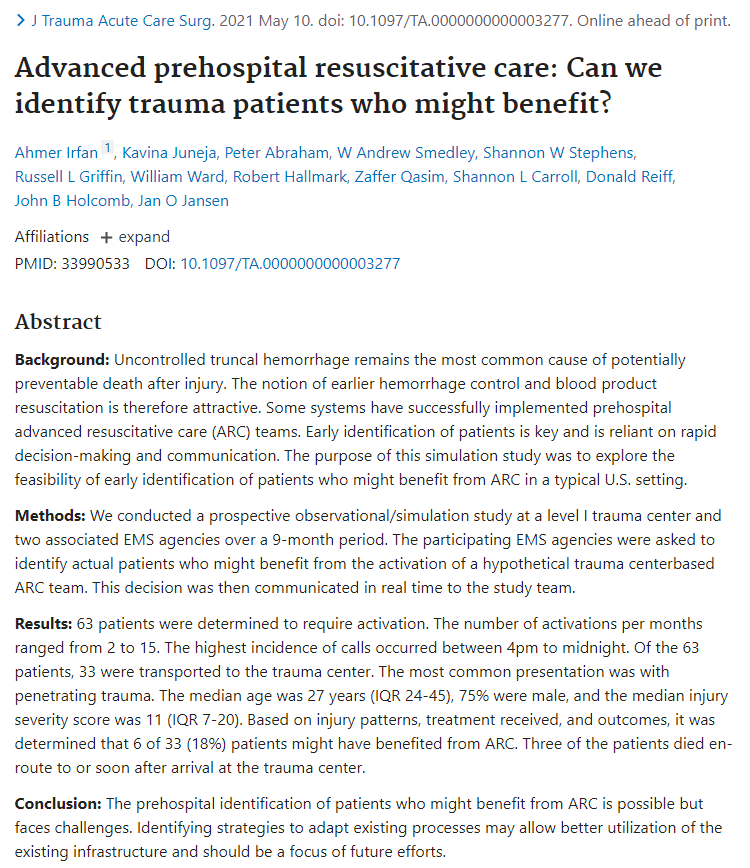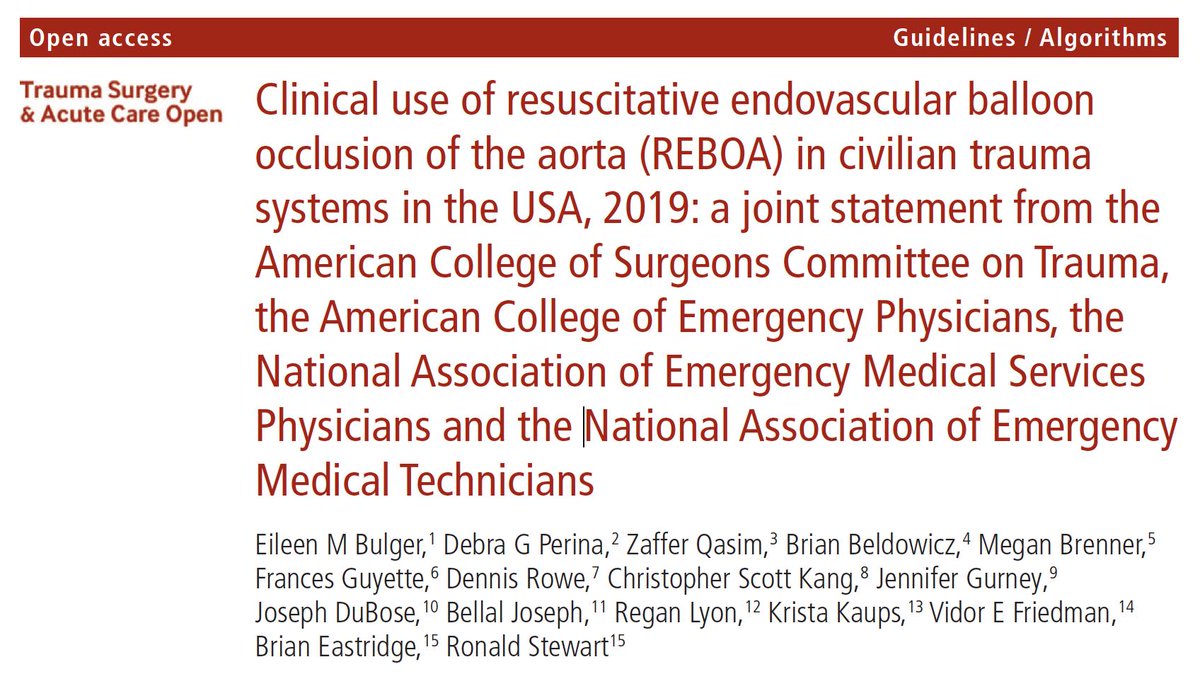
Let's focus again on potentially preventable death from torso #hemorrhage.
Our paper in @ShockJournal highlighted the need to refocus our efforts on the prehospital setting (🧵here:
But can we ID those patients successfully who might need ARC? 🧵
Our paper in @ShockJournal highlighted the need to refocus our efforts on the prehospital setting (🧵here:
https://twitter.com/resusone/status/1409859844086116358)
But can we ID those patients successfully who might need ARC? 🧵
2/
We attempt to do so in this paper published in @JTraumAcuteSurg
Link here: journals.lww.com/jtrauma/Abstra…
Thanks to lead author @AhmerIrfanMBChB and coauthors at @uabmedicine for their hard work
We attempt to do so in this paper published in @JTraumAcuteSurg
Link here: journals.lww.com/jtrauma/Abstra…
Thanks to lead author @AhmerIrfanMBChB and coauthors at @uabmedicine for their hard work

3/
To recap: Advances of in-hospital care have been profound over the last >3 decades-those reaching alive & not in irreversible shock has a v reasonable survival chance.
A subset of patients (as high as 45% in some series) die in the field or w/i 1 hour of hospital arrival
To recap: Advances of in-hospital care have been profound over the last >3 decades-those reaching alive & not in irreversible shock has a v reasonable survival chance.
A subset of patients (as high as 45% in some series) die in the field or w/i 1 hour of hospital arrival
4/
Death from high-grade torso bleeds occur w/i 30 min of point-of-injury (POI). There's an early peak w/i 1-2 hr for in-hospital death.
Holcomb showed time from POI to surgical hemorrhage control in some US trauma systems is a median 128 minutes...too late to help this group

Death from high-grade torso bleeds occur w/i 30 min of point-of-injury (POI). There's an early peak w/i 1-2 hr for in-hospital death.
Holcomb showed time from POI to surgical hemorrhage control in some US trauma systems is a median 128 minutes...too late to help this group


5/
Hence, our @ShockJournal paper pushed for considering (as the military as) specialist PH advanced resuscitative care (ARC) teams w/i trauma systems.
Critical for success is the ability to dispatch such a potential resource appropriately so it can arrive in time when needed
Hence, our @ShockJournal paper pushed for considering (as the military as) specialist PH advanced resuscitative care (ARC) teams w/i trauma systems.
Critical for success is the ability to dispatch such a potential resource appropriately so it can arrive in time when needed

6/
The challenge with US #EMS is its decentralized & disparate nature-one area may be served by multiple call centers/agencies.
Training & experience of dispatchers can be limited. This places challenges on developing an ARC model in current US prehospital (PH) systems
The challenge with US #EMS is its decentralized & disparate nature-one area may be served by multiple call centers/agencies.
Training & experience of dispatchers can be limited. This places challenges on developing an ARC model in current US prehospital (PH) systems
7/
Our prospective observation/simulation study aimed to explore feasibility of early patient ID who might benefit from ARC in a typical US PH setting.
Two EMS agencies (serving about 100,000 people) & feeding into a single L1TC were chosen and evaluated over a 9 month period
Our prospective observation/simulation study aimed to explore feasibility of early patient ID who might benefit from ARC in a typical US PH setting.
Two EMS agencies (serving about 100,000 people) & feeding into a single L1TC were chosen and evaluated over a 9 month period
8/
Both were asked to notify the L1TC/researchers (in real time) of actual patients who might benefit from the activation of a hypothetical trauma center-based ARC team (which could provide skills such as e.g. PH advanced airway/access/blood/#REBOA/thoracotomy)
Both were asked to notify the L1TC/researchers (in real time) of actual patients who might benefit from the activation of a hypothetical trauma center-based ARC team (which could provide skills such as e.g. PH advanced airway/access/blood/#REBOA/thoracotomy)

9/
Agencies approached this task differently.
-Push notification of @Active911 scene/patient info to a senior paramedic, who would then decide on ARC team activation
-training the dispatcher on clinical scenarios (e.g. abd GSW w/ AMS) where the ARC team should be dispatched
Agencies approached this task differently.
-Push notification of @Active911 scene/patient info to a senior paramedic, who would then decide on ARC team activation
-training the dispatcher on clinical scenarios (e.g. abd GSW w/ AMS) where the ARC team should be dispatched
10/
The study team would link PH and in-hospital data on these real patients. These were reviewed by experience investigators on appropriateness of the hypothetical ARC team activation & the potential benefit of that activation
PH times were calculated using geospatial data
The study team would link PH and in-hospital data on these real patients. These were reviewed by experience investigators on appropriateness of the hypothetical ARC team activation & the potential benefit of that activation
PH times were calculated using geospatial data
11/
Results:
-63 calls
-peak times 4p-midnight
-70% call-outs w/i 2 min of 911 call
-33 patients taken to study L1TC (remainder presumed to have gone to another center - data missing)
-injury mechanisms/characteristics in table
Detailed PH data not available in 40 patients
Results:
-63 calls
-peak times 4p-midnight
-70% call-outs w/i 2 min of 911 call
-33 patients taken to study L1TC (remainder presumed to have gone to another center - data missing)
-injury mechanisms/characteristics in table
Detailed PH data not available in 40 patients

12/
Of patients transported to L1TC
-5% intubated at scene
-10% intubated in ED
-2 patients arrested PH
-4 received chest tubes
-1 required thoracotomy
-38.3% required OR
-4 patients died (3 w/i 6 hours of POI)-all penetrating trauma patients
Of patients transported to L1TC
-5% intubated at scene
-10% intubated in ED
-2 patients arrested PH
-4 received chest tubes
-1 required thoracotomy
-38.3% required OR
-4 patients died (3 w/i 6 hours of POI)-all penetrating trauma patients
13/
Of our patient cohort, 10% were determined to possibly benefit from the hypothetical PH ARC team (table) to provide:
-surgical airway or difficult airway management
-thoracotomy
-transfusion
-chest decompression
-REBOA
Of our patient cohort, 10% were determined to possibly benefit from the hypothetical PH ARC team (table) to provide:
-surgical airway or difficult airway management
-thoracotomy
-transfusion
-chest decompression
-REBOA

14/
But would the team have arrived in time?
Data available for 31 patients
-median ARC ground travel time 22.9 min
-median air travel time 14.6 min
For the 6 who would benefit from ARC
-median predicted ground travel time 23.5 min
-median predicted air travel time 14.6 mins
But would the team have arrived in time?
Data available for 31 patients
-median ARC ground travel time 22.9 min
-median air travel time 14.6 min
For the 6 who would benefit from ARC
-median predicted ground travel time 23.5 min
-median predicted air travel time 14.6 mins
15/
We showed partial success in testing of the organizational elements critical to ARC team success (appropriate patient ID & dispatch to allow timely arrival)
What did we learn?
When ID'd, majority (70%) ARC team call-outs occurred w/i 2 min of 911 call
We showed partial success in testing of the organizational elements critical to ARC team success (appropriate patient ID & dispatch to allow timely arrival)
What did we learn?
When ID'd, majority (70%) ARC team call-outs occurred w/i 2 min of 911 call
16/
Although only 10% of our cohort would have benefited from ARC, likely this represents overtriage (inevitable as a system matures). This may be more refined with experience
We could not account for those just not ID'd by PH personnel or who may have died on scene
Although only 10% of our cohort would have benefited from ARC, likely this represents overtriage (inevitable as a system matures). This may be more refined with experience
We could not account for those just not ID'd by PH personnel or who may have died on scene
17/
Dispatcher training is crucial. To ID the patient who'd benefit from ARC team dispatch based on limited 911 call info under pressure requires experience.
Others have addressed this through having senior PH clinicians in dispatch centers, or even centralizing these centers
Dispatcher training is crucial. To ID the patient who'd benefit from ARC team dispatch based on limited 911 call info under pressure requires experience.
Others have addressed this through having senior PH clinicians in dispatch centers, or even centralizing these centers

18/
Although our study had limitations, we do highlight
-the need to address potentially preventable PH hemorrhage
-consideration for ARC teams
-the need for organizational change/support to implement such change
-the challenges/barriers in current US #EMS set up
Although our study had limitations, we do highlight
-the need to address potentially preventable PH hemorrhage
-consideration for ARC teams
-the need for organizational change/support to implement such change
-the challenges/barriers in current US #EMS set up
19/
I'll wrap it up by saying (again) that if we want to move the needle regarding potentially preventable mortality from torso/massive hemorrhage, we need to start taking steps to change/improve our current approach.
I'll wrap it up by saying (again) that if we want to move the needle regarding potentially preventable mortality from torso/massive hemorrhage, we need to start taking steps to change/improve our current approach.

• • •
Missing some Tweet in this thread? You can try to
force a refresh








